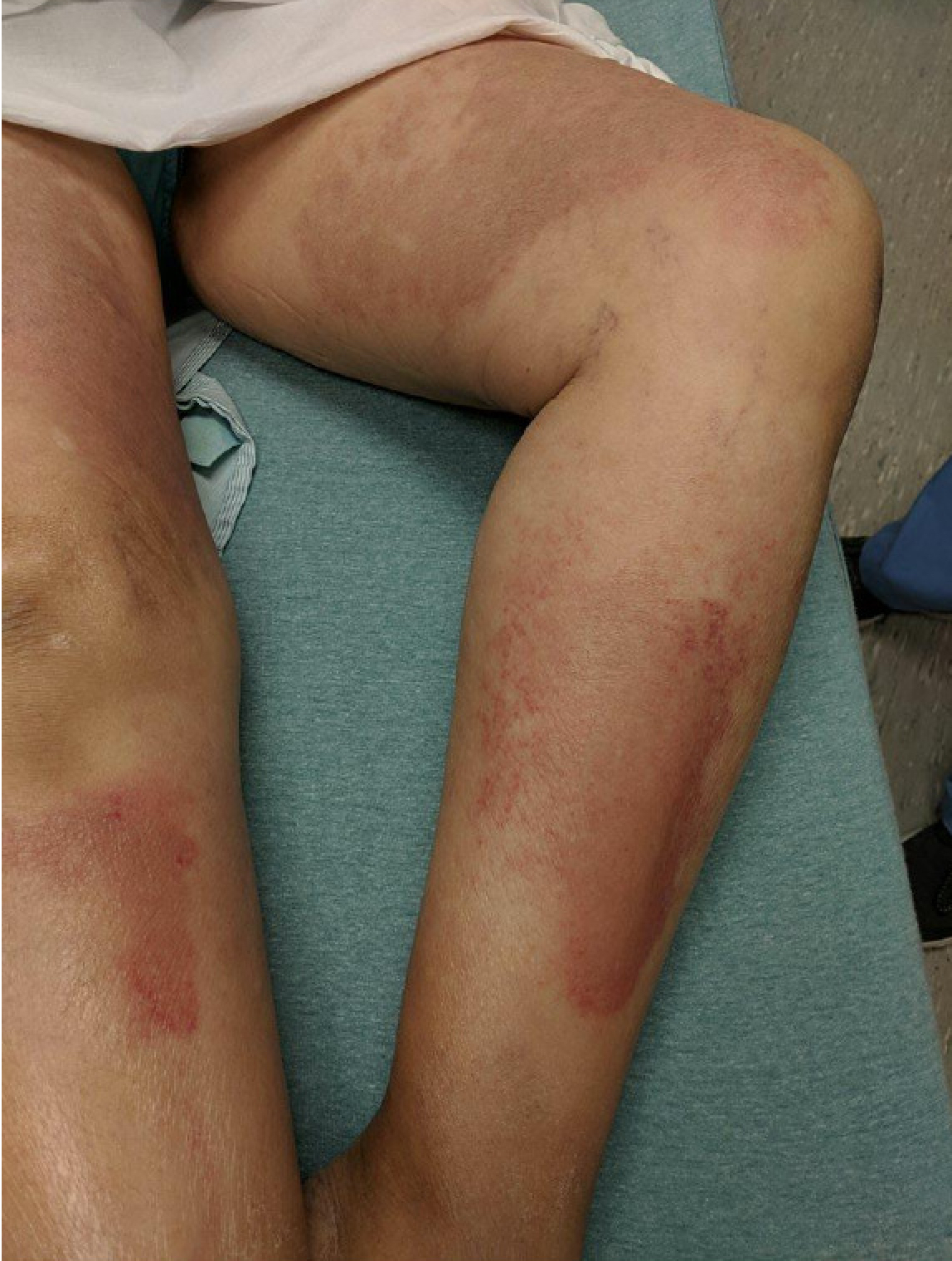Case Presentation: A previously healthy 68-year-old woman presented with three weeks of progressive abdominal and leg swelling. While visiting family in Mexico two weeks prior, she developed an itchy rash on her thighs that spread distally. She denied fever, cough, dysphagia, vomiting, or abdominal pain, but did report a six pound weight loss. Physical exam revealed temple wasting, decreased breath sounds at bases, ascites, and bilateral lower extremity edema. Additionally, both her thighs and shins were covered with pruritic, non-blanching erythematous, and hyperpigmented patches. Her laboratory studies were remarkable for normocytic anemia with a hemoglobin of 11.8g/dL, platelets 761K/uL, total protein 5.9 g/dL, and albumin 2.7 g/dL. Initial dermatology consult determined that the rash was pseudocellulitis, consistent with a paraneoplastic dermatosis. A CT scan of the abdomen and pelvis showed an eight centimeter complex right ovarian mass with large ascites and omental caking. Ascitic fluid revealed SAAG of 0.4 g/dL, and cytology was consistent with poorly differentiated adenocarcinoma with signet ring features; CK7 and CDX2 stains were positive, concerning for a gastrointestinal primary tumor. Esophagogastroduodenoscopy and colonoscopy showed an ulcerated, nodular gastric mass, and tissue biopsy confirmed gastric adenocarcinoma with signet ring features.
The patient was diagnosed with stage IV signet ring gastric adenocarcinoma with ovarian metastasis and peritoneal carcinomatosis. Her course was complicated by a submassive pulmonary embolism, rapid pulmonary lymphangitic spread with malignant effusion requiring pleural catheter placement, post-obstructive uropathy due to tumor compression requiring bilateral percutaneous nephrostomies, and pneumonia. Given the patient’s rapidly advancing cancer and poor prognosis, she elected for home hospice care
Discussion: Although the majority of ovarian neoplasms with omental metastases are primary ovarian malignancies, metastatic cancer may also present similarly. A Krunkenburg tumor is an ovarian neoplasm that has metastasized from another site, predominantly breast and gastrointestinal carcinoma. As in this case, primary gastric lesions may be missed on abdominal CT scans due to low sensitivity, Thus, tissue biopsy is essential for differentiating the origin of ovarian masses if other workup is unrevealing.
Numerous paraneoplastic dermatoses have been associated with gastric cancer. The most common of them is acanthosis nigricans, followed by dermatomyositis, erythroderma, and ichthyosis. To the authors’ knowledge, this is the first reported case of a Krukenburg tumor from a signet cell gastric adenocarcinoma presenting with a paraneoplastic dermatosis.
Conclusions: Paraneoplastic dermatoses can be an initial symptom of many cancers, and the ability to identify them is essential for initiating work-up of a potential malignancy. Although this patient’s initial work-up was consistent with a primary ovarian malignancy, tissue biopsy and further evaluation showed that her primary lesion was a gastric adenocarcinoma. Though rare, clinicians should include Krukenburg tumors in their differential diagnoses for ovarian masses.

